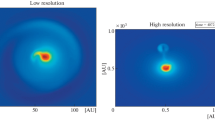Abstract
Present and future supercomputers offer many opportunities and advantages to attack complex and demanding industrial and applied mathematical problems, but provide also new challenges. In the Peta-Flops regime, these concern both, the way to exploit the increasingly available power and the need of designing algorithms which are scalable and fault-tolerant at the same time. An example of a probabilistic domain decomposition method, which is indeed scalable and naturally fault-tolerant, is presented. Grid computing should also be mentioned as an increasingly popular way to perform massively distributed computing: it represents a way to exploit computing power, aside the existing supercomputers. Beyond classical supercomputers there is the prospective quantum computer, in view of which it is advisable to start now a search for suitable algorithms for certain classes of problems.
Similar content being viewed by others
References
Acebrón JA, Busico MP, Lanucara P, Spigler R (2005) Domain decomposition solution of elliptic boundary-value problems. SIAM J Sci Comput 27(2):440–457
Acebrón JA, Busico MP, Lanucara P, Spigler R (2005) Probabilistically induced domain decomposition methods for elliptic boundary-value problems. J Comput Phys 210(2):421–438
Acebrón JA, Spigler R (2005) Fast simulations of stochastic differential systems. J Comput Phys 208:106–115
Childress S (1981) Mechanics of swimming and flying, cambridge studies in mathematical biology, 2. Cambridge University Press, Cambridge
Fagg G, Bukovsky A, Dongarra J (2001) Harness and fault tolerant MPI. Parallel Comput 27:1479–1495
Farhat C, Chandesris M (2003) Time-decomposed parallel time-integrators: theory and feasibility studies for fluid, structure, and fluid-structure applications. Int J Numer Meth Eng 58:1397–1434
Graham SL, Snir M, Patterson CA (eds) (2004) Getting up to speed. The future of supercomputing. Report of National Research Council of the National Academies Sciences, The National Academies Press, Washington, DC, 2004. http://www.nap.edu
Geist A, Engelmann C (2005) Super-scalable algorithms for computing on 100,000 processors. In: Lecture Notes in Computer Science, Springer, vol 3514, April 2005, pp 313–321
Keyes DE (1998) How scalable is domain decomposition in practice? In: 11th Int conf on domain decomposition methods, London 1998. http://www.ddm.org
Keyes DE (2002) Domain decomposition in the mainstream of computational science. In: 14th Int conf on domain decomposition methods, Morelos, México, 2002. http://www.ddm.org
Lions JL, Maday Y, Turinici G (2001) A parareal in time discretization of PDE’s. C.R. Acad Sci Paris 332:661–668
Nielsen MA, Chuang IL (2000) Quantum computation and information. Cambridge University Press, Cambridge
Nielsen MA, Dowling MR, Gu M, Doherty AC (2006) Quantum computation as geometry, Sci 311(24 February):1133–1135
Parolini N, Quarteroni A (2005) Mathematical models and numerical simulations for the America’s Cup. Comput Methods Appl Mech Eng 194 (9–11):1001–1026
Shor PW (1997) Polynomial-time algorithms for prime factorization and discrete logarithms on a quantum computer. SIAM J Comput 26:1484–1509
Shimasaki M, Zima HP (2004) The earth simulator, guest editorial, Parallel Comput 30(12):1277–1278
Special issue on Distributed Computing (2005) Sci 308(6 May)
Vidal G (2003) Efficient classical simulation of slightly entangled quantum computations. Phys Rev Lett 91:147902
Author information
Authors and Affiliations
Corresponding author
Rights and permissions
About this article
Cite this article
Acebrón, J.A., Spigler, R. Supercomputing applications to the numerical modeling of industrial and applied mathematics problems. J Supercomput 40, 67–80 (2007). https://doi.org/10.1007/s11227-006-0014-3
Published:
Issue Date:
DOI: https://doi.org/10.1007/s11227-006-0014-3




